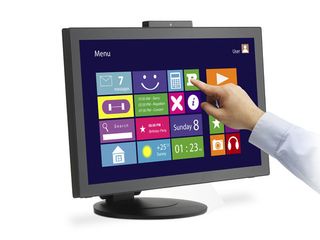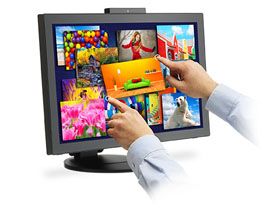Early Verdict
The ergonomic design and video performance of the E232WMT is first-rate and we found no flaws of consequence. Compared to other touchscreens, NEC is the easy winner.
Pros
- +
Stand design, built-in camera and microphone, image quality, contrast, true plug-and-play functionality
Cons
- -
Expensive
Why you can trust Tom's Hardware
NEC E232WMT 23" Touchscreen Monitor Review

The touchscreen has been around in various forms for many years. But until recently, you would only see them in places like science museums or at restaurant server stations. They didn’t really hit the mainstream until Apple introduced its iPhone. Then the floodgates opened with hundreds of me-too products from other mobile device manufacturers. Now we have tablets, phablets, and phones in every imaginable shape and size.
Adoption has been much slower on the desktop, since the two major operating systems, OS X and Windows, have only gradually enabled multi-touch functionality on hardware platforms. Why this is the case can be debated, but I think it comes down to a matter of ergonomics.
Using a touchscreen with a graphical OS is a good deal slower and less-precise than what we can do with a keyboard and mouse or trackball. Windows does a decent job with its Metro interface and those large buttons that require no precision at all to operate. Once you start scrolling through menus or try to select tiny radio buttons in a dialog box, though, navigation becomes a more difficult proposition.
We thought Windows 8 might spawn a multitude of new touchscreen-based displays. However, to date, we have only reviewed one monitor fitting that description, Dell’s P2714T. Today, we look at NEC’s entry, the E232WMT.
| Panel Type & Backlight | AH-IPS / W-LED, edge array |
|---|---|
| Screen Size & Aspect | 23-inch / 16:9 |
| Touch Layer | Projected capacitive10-point multi-touch |
| Max Resolution & Refresh | 1920x1080 @ 60 Hz |
| Native Color Depth & Gamut | 8-bit / sRGB |
| Response Time (GTG) | 5 ms |
| Brightness | 250 cd/m2 |
| Speakers | 2 x 1 W |
| Video Inputs | 1 x DVI, 1 x HDMI, 1 x VGA |
| Audio | 1 x 3.5 mm, 1 x headphone |
| USB | v3.0: 1 x up, 4 x down |
| Camera | 2 MP, 1920x1080, 30 FPS |
| Microphone | Stereo, digital |
| Panel DimensionsW x H x D | 22.1 x 14.3-16.4 x 9.8 in561 x 363-417 x 250 mm |
| Panel Thickness | 2.25 in / 57 mm |
| Bezel Width | 1 in / 25 mm |
| Weight | 16.8 lbs / 7.6 kg |
| Warranty | Three years |
NEC obviously started from scratch for the E232WMT’s design, beginning with an LED-lit AH-IPS panel at 1920x1080. Why not 2560x1440 or higher? You have to consider the size of on-screen objects and how that affects usability. Let’s just say that the resolution of the average index finger is poor, and if you want to interact with a PC's desktop, it can’t be packed with tiny icons and buttons. With a density of 96 pixels-per-inch, Windows objects are just the right size for easy selection.
The other major component in any touchscreen design is its stand, which most of us take for granted in typical desktop monitors. But a touchscreen only works if it is positioned comfortably. Interacting with a display in an upright position is impractical for anything but basic object selection like opening apps or placing a cursor, as examples. You really need to be able to lay it flat or at a steep keyboard-like angle.
NEC addresses this with a special stand that works accordion-style. It can position the E232WMT anywhere from perfectly flat to fully vertical and everywhere in between. An on-screen virtual keyboard suddenly becomes quite usable, and dragging or sizing objects is much easier when the screen is near-horizontal.
If you think about how people typically use tablets in their laps, the NEC’s design makes perfect sense. Like the Dell P2714T we reviewed back in January, the E232WMT supports 10-point multi-touch gestures like flick and pinch-to-zoom, which work in most applications.
NEC also adds a webcam and microphone to extend its functionality. These features are common on laptops and other portable devices, but only a few desktop monitors incorporate them. It all adds up to a potentially slick product. Let’s take a look.
Current page: NEC E232WMT 23" Touchscreen Monitor Review
Next Page Packaging, Physical Layout, And Accessories
Christian Eberle is a Contributing Editor for Tom's Hardware US. He's a veteran reviewer of A/V equipment, specializing in monitors. Christian began his obsession with tech when he built his first PC in 1991, a 286 running DOS 3.0 at a blazing 12MHz. In 2006, he undertook training from the Imaging Science Foundation in video calibration and testing and thus started a passion for precise imaging that persists to this day. He is also a professional musician with a degree from the New England Conservatory as a classical bassoonist which he used to good effect as a performer with the West Point Army Band from 1987 to 2013. He enjoys watching movies and listening to high-end audio in his custom-built home theater and can be seen riding trails near his home on a race-ready ICE VTX recumbent trike. Christian enjoys the endless summer in Florida where he lives with his wife and Chihuahua and plays with orchestras around the state.

Get $400 off Asus' stunning 42-inch 4K OLED gaming monitor — 138Hz ROG Swift PG42UQ drops to $999

US investigates China's access to RISC-V — open standard instruction set may become new site of US-China chip war

Hands-on with Hyte's Nexus Link: Huge-screen AIO cooler takes center stage, plus simplified cables and fans that snap together with magnets, making for easier PC building
-
joravecz Christian, you apparently didn't do your homework. There are multiple touchscreen models available from Viewsonic, Acer and others. To say the NEC is the second touchscreen after Dell looks incorrect to me. I've been waiting for reviews of those other models, but if you don't know they're out there I guess I'll be waiting for a while.Reply -
blackmagnum I have never thought that business-consumer minded NEC would sell touchscreen models. The FAR reaching effects of Windows 8!Reply -
therogerwilco LOLReply
since the two major operating systems, OS X and Windows
So that means the two major phone OS's are Android and Windows phone!
OSX isn't a major OS. It's at 6.74% right now. -
xenol The expensive con sort of irks me. Not that it's a con, but it just feels generically placed. Expensive compared to what? Someone may find all monitors over $200 too expensive, regardless.Reply
I dunno, just nitpicking. -
qlum ReplyLOL
It would probably be a lot lower if you disregard laptops. Maybe the Linux distros even surpass is then.
since the two major operating systems, OS X and Windows
So that means the two major phone OS's are Android and Windows phone!
OSX isn't a major OS. It's at 6.74% right now. -
gc9 "OSX isn't a major OS. It's at 6.74% right now."Reply
So by that reasoning, what do you think about the USA, which holds less than 4.5% of the world population? Higher spending customers are more important for some.
